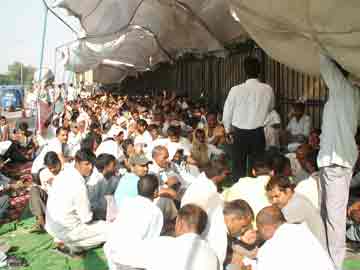
Archive 2009
|
October 16-31, 2009
Workers of auto anciliary units in Guragon-Manesar agitate for their demands
Nearly 25,000 workers spanning all trade unions in Gurgaon blocked the main Gurgaon highway in a massive rally on September 25. The rally was an expression of in solidarity with the auto ancillary units’ workers. Earlier, the Congress government in Haryana once again revealed its blatant anti worker attitude by detaining veteran AITUC leader and MP Gurudas Gupta and other leaders to prevent them from reaching the rally site. The workers’ agitation in the Gurgaon – Manesar industrial belt began nearly six months ago. It has been continuing in various forms since then. The workers are agitating for the right to form a union. They are agitating as well for higher wages.
According to D.L.Sachdeva, National Secretary of the AITUC, the management of Rico auto had suspended 16 workers for demanding recognition of their union by the company. The workers have submitted a letter to the Haryana government in August, asking for recognition of their union, which the Haryana government has kept pending. Following this, in the Rico and Sunbeam units about 2,500 and 1,000 workers respectively, have gone on strike. Sachdeva added that the unrest covers other facilities in the area such as TI Metals, Microtech, FCC Rico and Satyam Auto, although these are not on strike. Workers at Hondo Motors (HMSI) are also agitating for wage revision, Sachdeva said, adding that 17 workers have been suspended for participating in the agitation. The basic demand of the HMSI workers is for wage revision as per the industry average. The workers are also opposing the use of contract labour by the company after suspending the regular workers. Agitating workers have been on dharna outside the Rico and Sunbeam units for the past several weeks. On October 8 workers on dharna outside the Rico factory told correspondents of PV/MEL that when they reported for duty as usual on September21, they were told that the plant had closed down. Workers on dharna outside Sunbeam auto factory were agitated about the suspension of their colleagues by the management, for demanding the right to have their union registered. They also complained about the brutal attack on them by the police on October 22, in which dozens of workers were injured, 10 of whom are recovering in hospital. In the course of the current agitation, on October 10 the Japanese auto monopoly Honda Motors was threatening to close down operations at its wholly owned two-wheeler plant in the Gurgaon-Manesar belt and shift its operations to plants located elsewhere in the world. It is clear that the Japanese multinational is using this threat to browbeat the workers to accept their savage exploitation, and to get maximum concessions from the Haryana and Central governments. In this connection, the Honda management filed a petition in the High Court to end the agitation in their company and the strike in the auto ancillary units in the Gurgaon Manesar belt. Showing which class interests it defends, the Punjab and Haryana High Court has sent notices to the Haryana government and the workers’ union, asking them to file replies by October 15, terming the agitation by the workers a ‘major setback to foreign investor confidence in India’. No worker can have any illusion that the government and judiciary stand for the interests of the big Indian and foreign capitalists to make maximum profits and defends their right to super exploit the workers. It may be recalled that this was the same company in which, during an agitation in 2005, workers were brutally attacked in a large scale organized murderous attack by the Haryana police forces, who had been assembled from all over the state, while the workers were sitting in the premises of the local government authority to submit their petition. That brutal assault captured on Television had shocked the conscience of the entire country. In the course of the past two decades, massive industrialization is taking place in various new and old industrial hubs all over the country, driven by the policy of globalization through liberalization and privatization. All over the country, just like in the Gurgaon Manesar belt, young skilled workers, superexploited by the Indian and foreign multinationals, particularly in the industrial sector, but also in the services sector, are trying to organize themselves into unions and reduce the level of their exploitation. The class struggle is particularly intense in those sectors linked to export, and to ancillary units servicing multinationals, Indian and foreign. The State, in these sectors, is coming out with all its fangs against the workers to defend the superexplotation. Workers are fighting to unionise. Workers are fighting for the right to strike. Workers are fighting to improve their working conditions, their wages, and for other benefits. The state and the capitalists are using the slogan of “potential setback to foreign investor confidence in India’ to crush these struggles. The struggle of these young workers is an extremely good sign. It shows that the working class can and will paralyse the machinery of the bourgeoisie in defence of its rights. The task before communists is to assist the workers in organizing themselves in unions and federations, defend their right to unionise and right to strike, and to educate the class for the need to overthrow the rule of the capitalist and establish the rule of workers and peasants as the way to end exploitation of persons by persons. |


